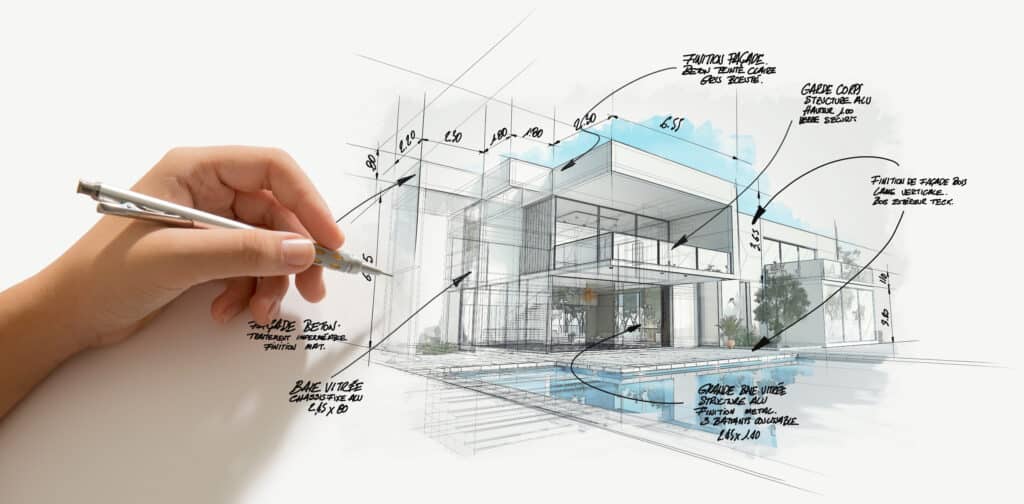Architect Career Path: Competencies, Studies, and Development Guide
Architect Career Path: Competencies, Studies, and Development Guide
Blog Article
Understanding the Diverse Job Paths Available for Aspiring Architect
As an ambitious Architect, you have a globe of profession courses waiting for you. Each course provides distinct obstacles and chances to use your creativity and technological expertise. Whether you're drawn to typical architecture or the subtleties of lasting design, there's a particular niche that aligns with your passions. Understanding these diverse choices can form your expert trip, but which direction will you pick to explore first?
Standard Style: Creating Frameworks and structures
Standard design concentrates on making buildings and structures that blend performance with aesthetic charm. Your styles can show social heritage, showcasing neighborhood practices while meeting contemporary requirements.
You'll create abilities in preparing, model-making, and website analysis, permitting you to envision and communicate your ideas successfully. Involving with clients, you'll need to recognize their vision and translate it right into possible styles.
Furthermore, developing codes and sustainability practices are necessary in your work, guaranteeing your structures are safe and ecologically friendly. As you grow in your profession, you'll find possibilities in residential, business, and even restoration tasks, each offering distinct challenges. Welcoming conventional style leads the way for a meeting occupation that pays homage to the past while forming the future.
Urban Planning: Forming Areas and Public Spaces
As a hopeful Architect, you can play an essential duty as an urban organizer, transforming just how communities function and connect. By employing area involvement methods, you'll guarantee that residents have a voice fit their environment. And also, incorporating lasting layout concepts will assist develop spaces that not just fulfill today's needs however additionally safeguard the future.
Function of Urban Planners
While several could believe of designers as the sole visionaries behind buildings, city organizers play a crucial duty in forming the wider landscape of neighborhoods and public areas. By collaborating with various stakeholders, you'll aid make parks, transport systems, and property locations that promote social interaction and accessibility. Your competence in spatial style and community characteristics allows you to envision future development while maintaining cultural heritage.
Community Engagement Approaches
Reliable community engagement techniques are crucial for city planners to guarantee that the voices of citizens are listened to and valued in the preparation process. To foster meaningful discussion, you should prioritize open online forums and workshops where neighborhood participants can express their concepts and problems. By proactively listening and including comments, you'll develop areas that mirror the community's demands, eventually leading to more effective and sustainable urban environments.
Lasting Layout Concepts
When creating metropolitan spaces, including sustainable design concepts is vital for producing atmospheres that thrive both environmentally and socially. Think about integrating environment-friendly areas, like parks and gardens, to improve biodiversity and improve air top quality.
Designing with water preservation in mind is additionally essential-- think concerning rain gardens and absorptive surfaces to take care of stormwater. Including area members throughout the preparation process guarantees that the areas you create satisfy their needs and urge social interaction. By accepting these principles, you'll add to dynamic, sustainable urban landscapes that benefit every person.

Landscape Architecture: Developing Lasting Outdoor Settings
As you check out landscape architecture, you'll uncover vital design concepts that create beautiful and useful outside spaces. Lasting practices play a crucial role in ensuring these atmospheres thrive while decreasing environmental influence. Plus, you'll locate a variety of job chances that allow you to make an actual difference in just how people connect with nature.
Design Concepts in Landscape
Recognizing style concepts in landscape design is necessary for producing lasting outside atmospheres that balance with nature. You'll need to contemplate elements like proportion, balance, and range to guarantee your designs feel natural and welcoming. In addition, pay focus to seasonal adjustments, designing with products that enhance the environments year-round.
Sustainable Practices Overview
Sustainable methods in landscape style not only focus on visual appeals yet also prioritize environmental wellness and source conservation. You can create rooms that advertise soil health and wellness, such as using organic products and practicing permaculture concepts. Ultimately, these techniques guarantee your layouts profit both people and the setting for years to come.
Profession Opportunities Expedition
With a strong structure in sustainable techniques, landscape design offers a selection of occupation paths that enable you to make a meaningful influence on the atmosphere. Urban planners usually work together with landscape architects to develop green rooms in urban setups, improving city livability. If you're passionate concerning education, take into consideration ending up being a landscape architecture instructor, inspiring future generations.
Sustainable Layout: Focusing on Eco-Friendly Practices
As you explore your occupation in style, accepting environmentally friendly techniques can set you apart in an affordable area. Sustainable style concentrates on creating buildings that decrease environmental effect while boosting occupant wellness. By including renewable materials, energy-efficient systems, and lasting structure techniques, you'll contribute to a greener future.
Beginning by gaining understanding of eco-friendly certifications like LEED or BREEAM, which can reinforce your qualifications. Consider how natural light, air flow, and thermal performance can maximize design. Collaborate with engineers and environmental experts to introduce solutions that reduce waste and conserve resources.
Don't fail to remember the value of area involvement-- interesting local stakeholders can inspire designs that integrate with the setting. As customers significantly focus on sustainability, your experience in eco-friendly practices will not just attract tasks yet additionally accomplish your interest for liable style. Accept this vital facet of the career, and enjoy your occupation grow.
Historic Preservation: Protecting and Restoring Social Heritage
While you start on your building journey, consider the essential role of historical conservation in preserving our cultural heritage. This area concentrates on the security and remediation of considerable buildings, websites, and frameworks that inform the stories of our past. By engaging in historical conservation, you'll assist protect the building tradition that shapes area identification.
As a historic preservation Architect, you'll analyze historic importance and analyze the condition of frameworks. You'll work very closely with guardians and historians to ensure genuine remediation strategies are utilized. This job path permits you to blend imagination with study, enabling you to create solutions that appreciate initial materials and workmanship.
Your job not only adds to sustainability by reusing existing structures yet likewise cultivates a feeling of pride within neighborhoods. Welcoming this path will aid you become a guardian of history, maintaining the tales and looks that enrich our lives.
Interior Design: Enhancing Indoor Spaces
Historical conservation and indoor architecture both share a commitment to improving the constructed setting, but they focus on different elements. While historical conservation emphasizes maintaining a structure's historic and social value, interior design nos in on maximizing interior spaces for performance and appearances.
As an aspiring Architect, you'll discover that indoor architecture allows you to mix creative thinking with technological abilities. You'll design spaces that not helpful site only look good but also promote convenience and performance. This area entails understanding how light, shade, and products connect within a room, influencing state of mind and use.
You'll function on numerous jobs, from property homes to industrial offices, guaranteeing that each environment meets the demands of its owners. By focusing on individual experience, you can transform interiors right into motivating and practical rooms, making a significant effect on just how people communicate with their surroundings. Welcome the chance to improve indoor settings and shape the method people function and live.
Industrial Style: Merging Capability With Aesthetics
Commercial style plays a necessary role in developing items that perfectly mix appearances with performance, ensuring that i was reading this what you make use of everyday is not just aesthetically appealing yet also practical. As an ambitious Architect, you can immerse on your own in this field, concentrating on creating everything from furnishings to consumer electronic devices. Your work entails recognizing user demands, materials, and making processes, allowing you to produce innovative options that enhance daily experiences.
In commercial style, you'll usually team up with marketers, designers, and suppliers, making sure that your styles are not only gorgeous but additionally viable. This occupation path offers a vibrant atmosphere where creativity fulfills functionality, making it a gratifying choice for engineers interested in shaping the products of tomorrow.
Regularly Asked Concerns
What Educational Qualifications Do I Required to End Up Being an Architect?
To come to be a designer, you'll need a specialist degree in style, usually a Bachelor's or Master's. Additionally, you'll need to finish a teaching fellowship and pass the Architect Registration Evaluation to practice lawfully.
Are There Qualification Requirements for Various Architectural Occupation Paths?
Yes, there're certification needs for various building courses. Architect. You'll need to pass tests, complete teaching fellowships, and in some cases seek specialized training, depending on your selected emphasis, like landscape architecture, city design, or historic conservation
What Software Application Abilities Are Important for Engineers Today?

How Can I Gain Practical Experience While Researching Design?
You can obtain functional experience by interning at architectural companies, joining layout competitions, offering for community jobs, or collaborating with schoolmates on real-world assignments. this page These chances enhance your skills and construct useful links in the industry.
What Work Opportunities Exist Outside Standard Architecture Firms?
You can check out numerous job chances outside typical architecture companies, like urban planning, interior decoration, landscape design, construction administration, property development, or perhaps duties in sustainability consulting. Each deals distinct difficulties and rewards.
Whether you're drawn to standard architecture or the nuances of lasting design, there's a specific niche that straightens with your interests.When creating city spaces, integrating lasting style concepts is vital for creating settings that prosper both environmentally and socially.As you explore landscape design, you'll uncover vital style concepts that develop practical and stunning outside areas.Recognizing layout concepts in landscape style is crucial for developing lasting exterior settings that balance with nature.In commercial style, you'll commonly work together with marketing professionals, designers, and producers, guaranteeing that your designs are not just attractive yet likewise feasible.
Report this page